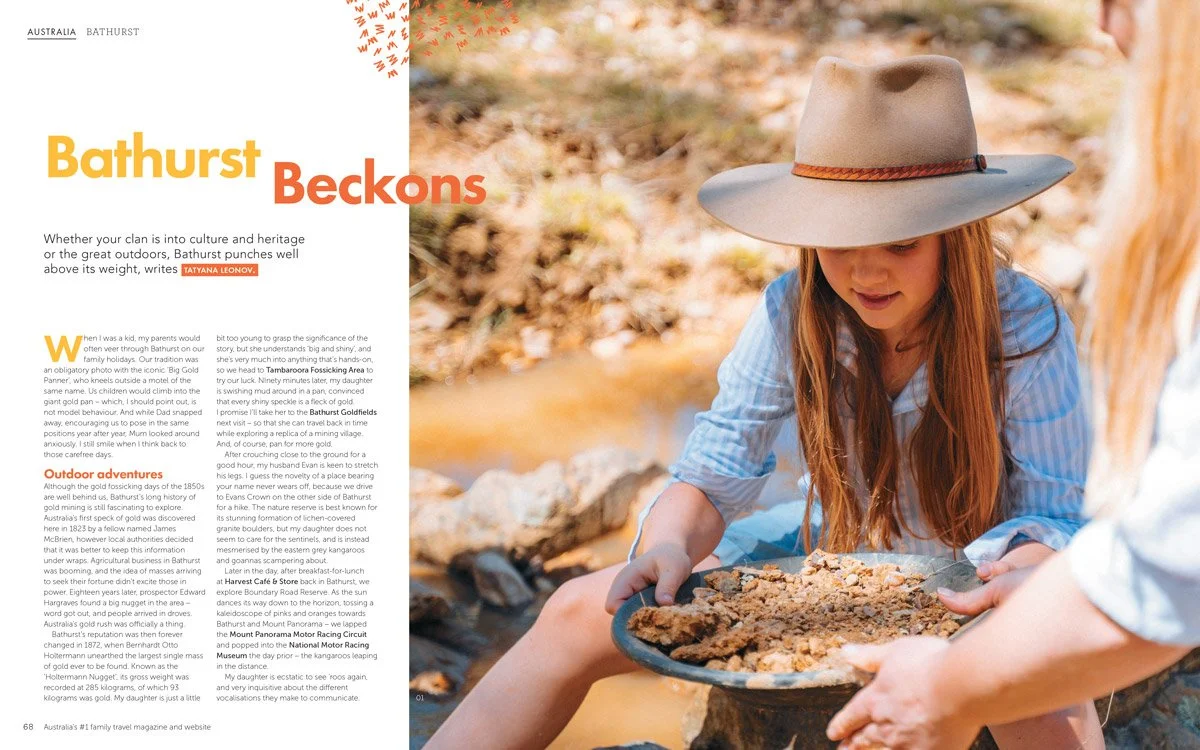Bathurst Beckons
Whether your clan is into culture and heritage or the great outdoors, Bathurst punches well above its weight, writes TATYANA LEONOV.
When I was a kid, my parents would often veer through Bathurst on our family holidays. Our tradition was an obligatory photo with the iconic ‘Big Gold Panner’, who kneels outside a motel of the same name. Us children would climb into the giant gold pan – which, I should point out, is not model behaviour. And while Dad snapped away, encouraging us to pose in the same positions year after year, Mum looked around anxiously. I still smile when I think back to those carefree days.
Outdoor adventures
Although the gold fossicking days of the 1850s are well behind us, Bathurst’s long history of gold mining is still fascinating to explore. Australia’s first speck of gold was discovered here in 1823 by a fellow named James McBrien, however local authorities decided that it was better to keep this information under wraps. Agricultural business in Bathurst was booming, and the idea of masses arriving to seek their fortune didn’t excite those in power. Eighteen years later, prospector Edward Hargraves found a big nugget in the area – word got out, and people arrived in droves. Australia’s gold rush was officially a thing.
Bathurst’s reputation was then forever changed in 1872, when Bernhardt Otto Holtermann unearthed the largest single mass of gold ever to be found. Known as the
‘Holtermann Nugget’, its gross weight was recorded at 285 kilograms, of which 93 kilograms was gold. My daughter is just a little bit too young to grasp the significance of the story, but she understands ‘big and shiny’, and she’s very much into anything that’s hands-on, so we head to Tambaroora Fossicking Area to try our luck. NInety minutes later, my daughter is swishing mud around in a pan, convinced that every shiny speckle is a fleck of gold.
I promise I’ll take her to the Bathurst Goldfields next visit – so that she can travel back in time while exploring a replica of a mining village. And, of course, pan for more gold.
After crouching close to the ground for a good hour, my husband Evan is keen to stretch his legs. I guess the novelty of a place bearing your name never wears off, because we drive to Evans Crown on the other side of Bathurst for a hike. The nature reserve is best known for its stunning formation of lichen-covered granite boulders, but my daughter does not seem to care for the sentinels, and is instead mesmerised by the eastern grey kangaroos and goannas scampering about.
Later in the day, after breakfast-for-lunch at Harvest Café & Store back in Bathurst, we explore Boundary Road Reserve. As the sun dances its way down to the horizon, tossing a kaleidoscope of pinks and oranges towards Bathurst and Mount Panorama – we lapped the Mount Panorama Motor Racing Circuit and popped into the National Motor Racing Museum the day prior – the kangaroos leaping in the distance.
My daughter is ecstatic to see ’roos again, and very inquisitive about the different vocalisations they make to communicate.
I have to Google the answer (apparently, they hiss, growl, click and chuckle). I suggest that we stay at Barcoos Farmstays next time we’re in this part of New South Wales, so she can spend days feeding quacking ducks and squawking chickens, riding friendly ponies, and baaaa-ing along out of tune with lambs.
A slice of history
Bathurst is Australia’s oldest inland European settlement, with ornate finds in every direction. Keppel Street, with its cast-iron lampposts positioned in the centre of the road, is the main drag for heritage building explorations. But rich history is all around. Swanky eateries are housed in buildings that were once glamorous hotels, and pretty cobblestone lanes are named after bushranger gangs.
Toddlers like treats, so we start a conversation about lollies at the cross-section of Bentinck and Keppel streets. We walk two blocks, admiring everything from Victorian terraces and Federation-era houses to Californian bungalows and inter-war-era homes, before our babycino intermission. It’s not long before we’re back on course to the Railway Station and Station Master’s Residence. The Victorian Tudor-style station is a pretty old thing, and right next to it is the Bathurst Railway Museum, which was opened to high acclaim in 2020.
The rail line between Sydney and Bathurst was completed in 1876, and it played a critical role in New South Wales’ growth, in both an economic and social sense. The museum’s timeline wall captures the fascinating succession, with local stories adding depth to the experience. For kids, there’s a public model railway line (the largest in the country) and the world’s largest Brio set to fiddle around with.
My daughter spends the next two days talking about her friend named Victoria (after hearing us talking about Victorian-era architecture), so we figure we’ll stay on theme and take her to Machattie Park for a roam around. The impressive space was opened toward the end of 1890, and some of the structures from its heyday – such as The Grand Fountain, Band Stand Rotunda and Gardener’s Cottage – are still proudly standing.
I picture Victorian-era families walking together hand-in-hand, admiring the silver elms, English oaks and red beeches, but the reality is that kids – regardless of what historical era they live in – love to run around here… and run amok.
My daughter sprints all the way to the Australian Fossil and Mineral Museum (holding my hand, of course), striding her little legs as far as they can stretch after our park meander. We’ve asked her to re-enact a dinosaur gait and have made amazing time. The Somerville Collection – a fascinating assemblage of approximately 5,000 objects showcasing different stages of life on Earth – is the main exhibition, but my daughter is most impressed by the huge Tyrannosaurus Rex cast… which she names Victoria.






